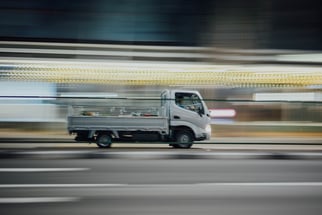Suppose you are a fleet manager or someone with responsibility for multiple vehicles in a business fleet. In that case, you may be wondering how to reduce idling.
In any transportation, idling can be wasteful and inefficient. This guide will cover why controlling idling is significant and discuss how to reduce idling in a business fleet.
What Is Idling and Why Does It Matter?
Idling is when a truck or vehicle runs its engine while not moving. There are many reasons for idling, including being stuck in traffic, temporarily parked, and trying to maintain a cabin temperature by running the engine along with heating and air conditioning systems.
Here's why idling matters — statistics show that reducing idling contributes to much better fuel efficiency and cost reduction for business fleets. It will also lead to a smaller carbon footprint, which is vital in managing climate change and the emission of greenhouse gases into our environment.
New efficiency and performance initiatives have made companies focus on reducing idling in fleet management. Reducing idling is now something that many business owners and managers see as a good thing to do for all of the above reasons. Who doesn't want to save resources? For instance, if a package delivery company can show how it reduced fuel consumption and cost by reducing idling, that's less operating costs.
How to Reduce Idling
There are a few critical ways that fleet managers and other business leaders can reduce idling when business vehicles are doing their work out in the field. Some of these programs are valuable in handling the costs of a fleet and adding efficiencies that give managers bragging rights.
Driver Training and Incentives
One of the best ways to promote fewer instances of idling (and/or shorter instances) is to train drivers extensively on why this is important. Companies should plan to have an onboarding conversation with new drivers about why less idling benefits the company and the driver and directly show how incentives are applied.
The more training and incentives the company has put in place, the more drivers will comply with requests for shorter idling times.
Using Available Idling Alerts and Reporting Systems
There are also new electronic tools that companies can use to keep track of idling in a business fleet.
With some of these new software products, alerts kick in in real-time after a vehicle has been idle for a short period (ex: a few seconds). These can be added to reporting that shows business leaders when and where idling occurs. This knowledge helps stakeholders to figure out how to reduce that idling and focus on the situations where vehicles are consuming too much unnecessary fuel.
Utilizing IRTs and Providing Auxiliary Services
Another crucial part of reducing idling is to untether the combustion engine's operation from essential cabin services like heating, air conditioning, and electrical.
The EPA has identified technologies that can help with this process. It calls them Idling Reduction Technologies or IRTs.
Auxiliary power units and other IRTs will help planners (like fleet managers) to reduce fleet idling. A fuel heater will help to maintain heat in the cabin with the engine off. A battery-run air conditioning system will help to provide air conditioning, again, without running the engine. Auxiliary batteries and electrification systems will maintain radio or device charging without the vehicle's engine.
Tips and Reminders for Idling Reductions
Need help with how to cut down on business fleet idling time?
To recap, there are three significant ways to target idling with new systems and approaches.
- Training and incentives
- Alerts and reporting
- Auxiliary and alternative services
You can also refer to more EPA resources and other expert analyses of how to reduce idling with business vehicles.
Reduce Idling: Fleet Management Services
Fleet management services and tools can help with software services that automate the assessment of idling in business vehicles. The reports that these services can generate greatly help business decision-makers identify the sources of idling and figure out how to reduce those activities.
An energy reduction resource from the Federal Office of Energy's Efficiency and Renewable Energy department talks about research projects aimed at reducing idling through several policies and methods.
It refers to long-haul vehicle operators using lithium-ion batteries to run air conditioning, heating, and electronics at rest stops. That practice will cut down on the fuel used by the combustion engine to preserve those cabin comforts or, alternately, cabin electrical power that supports a driver's clerical work requirements.
Other specific tools include truck stop electrification locators and idle reduction calculators that show the savings clearly. The Clean Cities Coalition offers Idlebox, a toolkit for fleet managers. Along with general notes on engagement and education, the Idlebox has substantial resources like decals, signs, and cards. The reference materials aimed at helping drivers and other stakeholders discover the positives of idling reduction, including the recovered costs, the benefit to the environment, and the cost of non-compliance in various states.
The American Transportation Research Institute also maintains a database of anti-idling laws, and fleet managers can review things like weight restrictions for local transport operations. A cab card shows drivers where and how idling can be fined in states like Arizona, California, Delaware, and elsewhere.
Training to Help Reduce Idling Fleets
In terms of training, group training can be conducted during onboarding new fleet drivers. There's also individual training where companies can select one or more drivers for one-on-one conversations and instruction about how to limit idling time as needed.
Both of these kinds of training can ultimately be effective in getting everyone on the same page, which, experts say, is often a question of showing the positives and negatives clearly.
Getting employees to proactively modify their driving behavior can be a way to stay agile in reducing idling time.
Contact us to learn more about how to save gas and reduce idling for a fleet. The tools provided by Linxup are critical resources in the fight against unnecessary costs, harmful fuel emissions, and general inefficiencies in a vital line of work.
Transportation powers America, and intelligent transportation preserves the future. Reducing idling is a significant part of that, so much so that states have put in place significant idling penalties and incentives for efficiency.
Let Linxup be part of the solution to a real problem.
Interested to explore more of our GPS trackers? Or check out our most popular GPS tracker here. Feel free to get in touch with our friendly sales team, click here on your phone or dial 1-877-907-0801 and start the steps necessary to reduce idling today.



